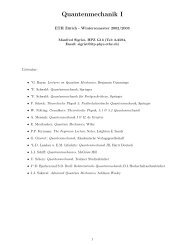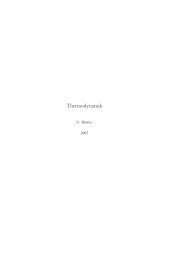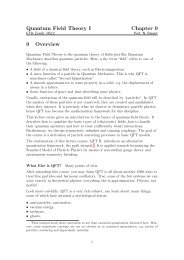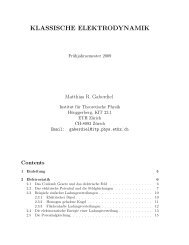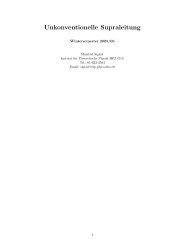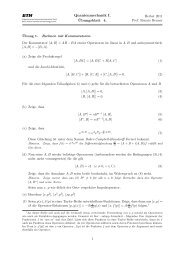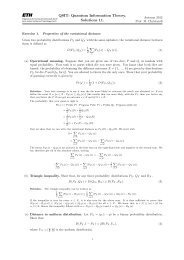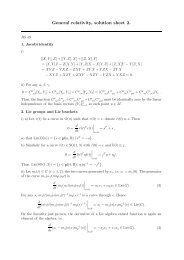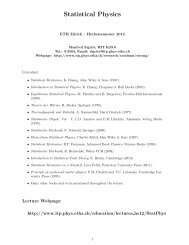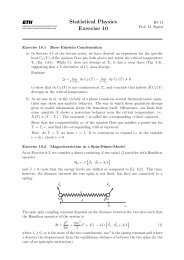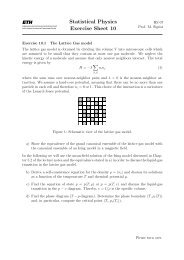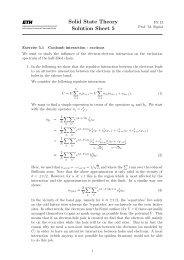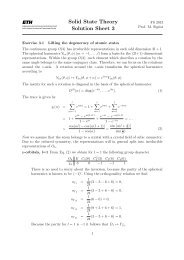General relativity, exercise sheet 3.
General relativity, exercise sheet 3.
General relativity, exercise sheet 3.
You also want an ePaper? Increase the reach of your titles
YUMPU automatically turns print PDFs into web optimized ePapers that Google loves.
<strong>General</strong> <strong>relativity</strong>, <strong>exercise</strong> <strong>sheet</strong> <strong>3.</strong><br />
HS 08 Due: Fri, October 17, 2008<br />
1. Parallel transport in polar coordinates<br />
Consider the euclidean plane R 2 ∋ (x 1 , x 2 ) = x as a manifold with chart: id : x ↦→ x.<br />
Define a cartesian parallel transport T x (R 2 ) ∋ v ↦→ v ′ ∈ T x ′(R 2 ) along any curve by<br />
requiring that v and v ′ have the same components. Compute the Christoffel symbols of<br />
this parallel transport in polar coordinates r, ϕ.<br />
2. Affine connections<br />
Show: given an affine connection ∇ on the manifold M, ˜∇ is an affine connection iff the<br />
difference B(X, Y ) := ∇ X Y − ˜∇ X Y has the property that<br />
(ω, X, Y ) ↦−→ 〈ω, B(W, Y )〉<br />
is a tensor field of type ( 1<br />
2)<br />
(i.e. the affine connections on M form an affine space over the<br />
vector space of these tensor fields).<br />
What are the consequences of this fact for the Christoffel symbols?<br />
Application: for every pair of affine connections ∇, ˜∇ the combination (1 − α)∇ + α ˜∇ is<br />
also an affine connection.<br />
<strong>3.</strong> Alternate view on parallel transport<br />
The tangent bundle of a manifold M is the union of all its tangent spaces:<br />
TM = ⋃<br />
T p (M)<br />
p∈M<br />
Let π be the projection π : TM → M, X ↦→ π(X) = p if X ∈ T p (M).<br />
T p (M)<br />
TM<br />
π<br />
p<br />
π −1 (U)<br />
M<br />
U<br />
The tangent bundle becomes a differentiable manifold in its own right by means of charts
defined as follows: If K : U → R n p ↦→ x = (x 1 , . . .x n ) is a patch for U ⊂ M, then<br />
˜K : π −1 (U) −→ R n × R n (1)<br />
X ↦−→ (x, X) ,<br />
where X = (X 1 , . . .X n ) are the components of X ∈ T p (M) w.r.t. the coordinate basis, is<br />
a patch for π −1 (U) := ⋃ p∈U T p(M) ⊂ TM.<br />
i) Let ¯x ↦→ x be a coordinate change on U ∩ Ū ⊂ M. Compute the induced coordinate<br />
change on π −1 (U ∩ Ū). What is the matrix of its partial derivatives?<br />
A parallel transport can be viewed as a map<br />
σ X : T π(X) (M) −→ T X (TM) ,<br />
Y ↦−→ σ X (Y ) , (X ∈ TM)<br />
such that in any chart (1)<br />
σ X (Y ) ′′ = ′′ ( Y , −Γ(Y , X) )<br />
with Γ linear in Y , X : Γ(Y , X) i = Γ i lk Y l X k where Γ i lk are the Christoffel symbols of the<br />
parallel transport ( ′′ = ′′ is short for the tangent map ˜K ∗ ; we refrain from giving a more<br />
intrinsic definition).<br />
ii) Show that a vector X(t) parallel transported along a curve γ(t) in M is characterized<br />
by<br />
π ( X(t) ) = γ(t) ,<br />
Ẋ(t) = σ X(t)<br />
(˙γ(t)<br />
)<br />
.<br />
Hint: A family of vectors X(t) ∈ T γ(t) is a curve in TM. Hence Ẋ(t) ∈ T X(t)(TM).<br />
iii) Components of vectors in T X (TM) transform ”tensorially” by means of the matrix<br />
found in i). Derive from that the non-tensorial transformation law for the Christoffel<br />
symbols.



